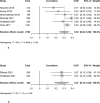The relationship between smartphone addiction and sleep among medical students: A systematic review and meta-analysis
- PMID: 37713408
- PMCID: PMC10503710
- DOI: 10.1371/journal.pone.0290724
The relationship between smartphone addiction and sleep among medical students: A systematic review and meta-analysis
Abstract
Objectives: This systematic review aimed to evaluate the association between smartphone addiction and sleep in medical students. The secondary outcomes included the prevalence of smartphone addiction, duration and purpose of its use, prevalence of poor sleep, duration and quality of sleep.
Methods: The authors searched PubMed, Cochrane Library, Embase, PsycINFO and CINAHL databases, from inception of each database to October 2022. Quantitative studies in the English language on smartphone addiction and sleep in students studying Western Medicine were included. The Rayyan application was used for title-abstract screening, and Joanna Briggs Institute (JBI) critical appraisal checklist to assess the risk of bias. Heterogeneity tests and meta-synthesis of data were performed using the meta-package in R software. Data on the activities used on the smartphone was synthesized qualitatively.
Results: A total of 298 abstracts were initially assessed for inclusion eligibility: 16 of them were eventually appraised, covering 9466 medical students comprising 3781 (39.9%) males and 5161 (54.5%) females. Meta-correlation between the Smartphone Addiction Scale Short Version (SAS-SV) and Pittsburgh Sleep Quality Index (PSQI) was 0.30 (95%CI = 0.24-0.36), and 0.27 (95% CI = 0.18-0.36) for SAS-SV and sleep duration. The meta-analytic estimation of smartphone addiction prevalence was 39% (95%CI = 0.30-0.50), and score using SAS-SV was 31.11 (95%CI = 29.50-32.72). The mean duration of smartphone daily used was 4.90 hours (95%CI = 3.72-6.08). The meta-analytic estimation on prevalence of poor sleep was 57% (95%CI = 0.48-0.66), and the meta-mean of PSQI and duration of sleep was 5.95 (95%CI = 4.90-7.00) and 5.62h (95%CI = 4.87-6.36) respectively. Medical students used their smartphones mostly for text messaging, followed by photo-sharing or social networking. Its usage for medical education remains unclear.
Conclusion: The prevalence of poor sleep and smartphone addiction in medical students was 57% and 39% respectively, with a correlation index of 0.30. Medical students commonly used the smartphone for text-messaging, photo-sharing or social networking, averaging 4.9 hours daily.
Copyright: © 2023 Leow et al. This is an open access article distributed under the terms of the Creative Commons Attribution License, which permits unrestricted use, distribution, and reproduction in any medium, provided the original author and source are credited.
Conflict of interest statement
The authors have declared that no competing interests exist.
Figures





References
-
- How Many Smartphones Are In the World? [Internet]. Statista. 2022. Available from: https://www.statista.com/statistics/330695/number-of-smartphone-users-wo...
-
- Müller J. Smartphone usage among residents in Singapore 2016–2020, by age group [Internet]. Statista. 2021. Available from: https://www.statista.com/statistics/1266889/singapore-smartphone-usage-b....
-
- Average daily time spent on mobile internet among internet users in Singapore from 3rd quarter 2019 to 3rd quarter 2021 [Internet]. Statista. 2022. Available from: https://www.statista.com/statistics/1327789/singapore-daily-time-spent-o...
-
- Billieux J. Problematic Use of the Mobile Phone: A Literature Review and a Pathways Model. Current Psychiatry Reviews. 2012;8(4):299–307.
Publication types
MeSH terms
Associated data
LinkOut - more resources
Full Text Sources

